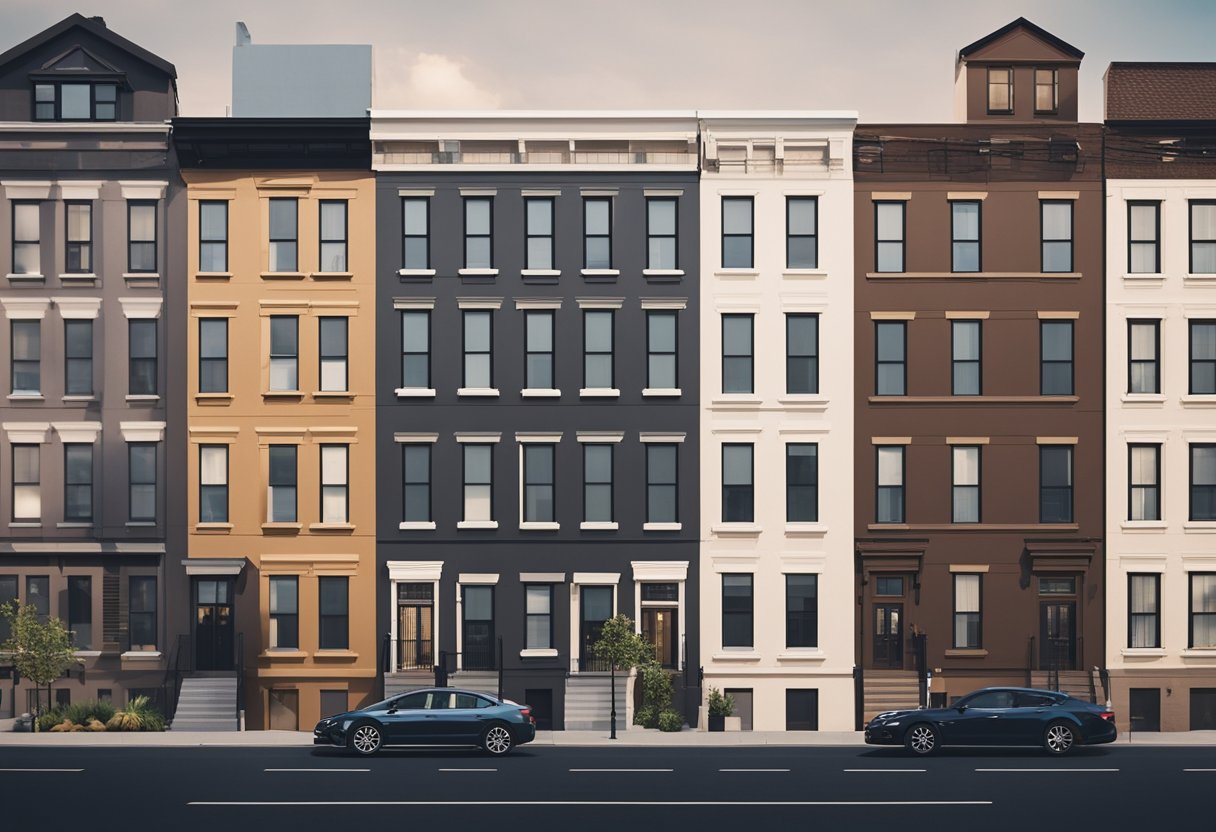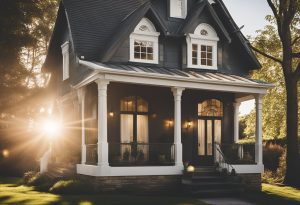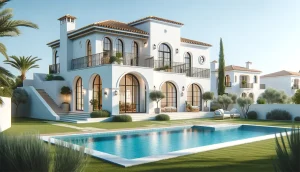Flats and apartments are often used interchangeably to describe a self-contained living unit within a larger building. However, there are differences between the two that may affect your decision when choosing a place to live. In British English, a flat is a set of rooms on one floor within a larger building. The term “apartment” is more commonly used in American English, but in British English, it generally refers to a high-end, spacious flat. Flats can be found in a variety of buildings, including converted houses, purpose-built blocks, and high-rise towers. They can be rented or owned, and may be furnished or unfurnished.
When it comes to apartments, they are usually found in larger, purpose-built buildings and are often rented rather than owned. They can range from small studios to spacious multi-bedroom units, and may come fully furnished or unfurnished. The term “apartment” is also used to describe a unit within a larger building that has been converted from a different use, such as a warehouse or factory.
𝐅𝐥𝐚𝐭 𝐯𝐬 𝐀𝐩𝐚𝐫𝐭𝐦𝐞𝐧𝐭: What is the Difference Between A Flat and An Apartment?
What Is a Flat?
A flat is a self-contained residential unit that occupies part of a larger building. It is typically found in multi-storey buildings and can vary in size and layout. Flats are commonly associated with low to middle-class accommodation, and they are often occupied by individuals or small families. The term “flat” may also imply a single-storey residence, although this can vary depending on regional interpretations.
What Is an Apartment?
An apartment refers to a self-contained living space that is part of a larger building containing multiple such units. Apartments are often associated with more luxurious and refined living, and they are commonly occupied by individuals from the upper and higher classes. Unlike flats, apartments can be multi-storeyed and may offer various amenities and facilities for residents’ convenience and comfort.
Historical Context of Flat vs Apartment
Though “flat” and “apartment” are often used interchangeably, their historical roots reveal subtle distinctions that reflect cultural and linguistic differences. Understanding the origins and evolution of these terms helps clarify how they are used in different parts of the world.
The Origin of Flat
The term “flat” is primarily associated with the United Kingdom and is commonly used to describe a self-contained living unit within a larger building. In older buildings, the term “flat” was often used for residences that spanned multiple levels. Today, however, it can refer to both single-level and multi-level units.
“Flat” is thought to have been derived from the French word appartement, which means a separate or distinct living space. The term gained popularity in the UK during the 19th century, a time when urbanization and industrialization led to the rapid growth of high-density housing. As cities became more crowded, the need for efficient, compact living spaces gave rise to the widespread use of flats.
The Origin of Apartment
The term “apartment” is more commonly used in the United States and refers to a self-contained, usually single-level unit within a larger building. Like “flat,” “apartment” also originates from the French appartement, which shares the meaning of a separate or distinct living space.
In the United States, the use of “apartment” became widespread in the early 20th century, coinciding with a period of rapid urbanization and population growth. As the demand for housing in cities grew, the apartment building model became a practical solution for accommodating large numbers of residents in limited space. The term “apartment” thus became the standard in American English to describe these types of residential units.
Key Differences
The primary difference between “flat” and “apartment” lies in regional usage. In the UK and many Commonwealth countries, “flat” is the preferred term, while in the US, “apartment” is the more common choice. Despite these regional preferences, both terms describe similar types of self-contained living units within larger buildings, differing mainly in linguistic and historical context.
In essence, the distinction between “flat” and “apartment” is a reflection of the specific linguistic and cultural influences in different regions, rather than any significant difference in the type of dwelling itself. Understanding this historical context allows for a clearer appreciation of how language shapes our perception of living spaces.
Types of Flats and Apartments in India
Flats in Noida, India
Noida is a city in India that has seen rapid development in recent years. It is known for its modern infrastructure, excellent connectivity, and affordable housing options. Flats in Noida are available in different sizes and configurations, ranging from 1 BHK to 4 BHK.
The most popular types of flats in Noida are:
- Studio Apartments: These are small flats that consist of a single room that serves as the living room, bedroom, and kitchen.
- 1 BHK Flats: These flats have a separate bedroom, living room, and kitchen.
- 2 BHK Flats: These flats have two bedrooms, a living room, and a kitchen.
- 3 BHK Flats: These flats have three bedrooms, a living room, and a kitchen.
- 4 BHK Flats: These flats have four bedrooms, a living room, and a kitchen.
For a comprehensive understanding of BHK configurations, you can refer to this essential guide.
Ready to Move Apartments in Noida Extension
Noida Extension is an upcoming area in Noida that is known for its affordable housing projects. Ready to move apartments in Noida Extension are in high demand due to their affordable prices and excellent location.
Some of the popular ready to move apartments in Noida Extension are:
- Gaur City: This is a residential project that offers 2 BHK and 3 BHK flats with modern amenities such as a swimming pool, gym, and clubhouse.
- RENOX: This is a residential project that offers 3 BHK, and 4 BHK flats with amenities such as a swimming pool, gym, and landscaped gardens.
- NCR Monarch: This is a residential project that offers 1 BHK, 2 BHK, and 3 BHK apartments with amenities such as a swimming pool, gym, and clubhouse.
- Ace Hanei: A modern residential project offering a variety of flat configurations with contemporary amenities, ideal for comfortable living.
Overall, the types of flats and apartments available in India cater to different budgets and lifestyles. With the rapid development of cities like Noida, there are many affordable housing options available for those looking to buy or rent a flat or apartment. For more information on various residential projects, you can visit the listed residential projects in Noida.
Architectural Differences
Building Structure
The primary difference between a flat and an apartment is the building structure. Flats are generally single residential units that occupy a single floor of a building, while apartments typically have multiple residential units on a single floor. Apartments are usually part of a larger building complex, while flats are often standalone buildings.
Design and Layout
Flats and apartments also differ in their design and layout. Flats typically have a more basic design and layout, with fewer amenities and features than apartments. They are often smaller in size and have fewer rooms than apartments. In contrast, apartments are generally larger in size and have more rooms, with features such as balconies, patios, and communal areas.
Apartments are also more likely to have additional amenities, such as a gym, swimming pool, or communal garden. Flats, on the other hand, are usually more basic in terms of amenities and often do not have additional features.
In summary, flats and apartments differ in their building structure, design, and layout. While flats are generally single residential units on a single floor, apartments have multiple residential units on a single floor and are often part of a larger building complex. Apartments are usually larger in size and have more amenities and features than flats.
Legal and Ownership Distinctions
When it comes to legal and ownership distinctions between flats and apartments, there are a few key differences to keep in mind. These differences can have a significant impact on the rights and responsibilities of tenants and owners alike.
Leasehold and Freehold
One of the most significant differences between flats and apartments is the way they are owned. Flats are typically owned on a leasehold basis, which means that the owner of the building retains ownership of the land and the tenant only owns the right to occupy the property for a specified period of time. On the other hand, apartments are typically owned on a freehold basis, which means that the owner of the apartment also owns a share of the land and any common areas associated with the building.
This distinction can have important implications for tenants and owners alike. For example, leasehold properties may be subject to ground rent and service charges, which can increase over time and make the property less affordable in the long run. Freehold properties, on the other hand, may offer more security and control over the property, as well as the ability to make changes and improvements without seeking permission from a landlord.
Rental Agreements
Another key difference between flats and apartments is the nature of the rental agreement. Flats are typically rented from a landlord or property management company, and tenants may be subject to strict rules and regulations regarding their use of the property. For example, tenants may be prohibited from keeping pets, smoking, or making alterations to the property without the landlord’s permission.
Apartments, on the other hand, may offer more flexibility and freedom for tenants. Because the owner of the apartment also owns a share of the building, tenants may have more say in how the building is managed and maintained. Additionally, tenants may be able to make changes and improvements to their apartment without seeking permission from a landlord, as long as they do not affect the structural integrity of the building or other units.
Overall, it is important for tenants and owners alike to understand the legal and ownership distinctions between flats and apartments. By doing so, they can make informed decisions about their property and ensure that their rights and responsibilities are protected.
Cultural Perceptions
The terms “flat” and “apartment” not only differ in their linguistic usage but also in their cultural perceptions. These differences reflect the divergences between British English and the English spoken in other countries.
Social Status
In the UK, the term “flat” is often associated with low to middle-class accommodation, while “apartment” is linked to more luxurious and refined living. On the other hand, in the US, the term “apartment” is more commonly used regardless of the social status of the residents. This linguistic distinction reflects the differences in the social and cultural values of the two countries.
Lifestyle Implications
The phrases’ cultural connotations are another difference. In some situations, the term “flat” may refer to a more basic or functional living area, whereas “apartment” may refer to a more expensive or high-end residence. These meanings can change depending on regional use and personal viewpoints, though. For instance, in London, the term “flat” is used to describe a wide range of living spaces, including luxurious penthouses and studio apartments.
Overall, the difference between “flat” and “apartment” lies in their cultural perceptions and linguistic usage. While the two terms are synonymous and convey similar residential contexts, they symbolize the rich, divergent linguistic landscapes of the UK and other English-speaking countries.
Market Trends and Pricing
Affordability
When it comes to affordability, flats and apartments have different price ranges. According to some popular real estate companies, the price of apartments in India is generally higher than that of flats due to the additional amenities and facilities provided. Flats, on the other hand, are more affordable and suitable for people on a budget. This is because they are usually smaller and have fewer amenities. It is important to note that the prices of both flats and apartments vary depending on the location, size, and quality of construction.
Investment Potential
In terms of investment potential, apartments are considered to be a better option than flats. According to Real Homez, apartments have a higher resale value and offer better returns on investment due to their modern amenities and facilities. In addition, apartments are usually located in prime locations, which further increases their value. However, flats can also be a good investment option, especially for people looking to buy a property for rental income. Flats are more affordable and easier to rent out, which makes them a popular choice among investors.
Overall, both flats and apartments have their own advantages and disadvantages in terms of affordability and investment potential. It is important to consider one’s budget, location preferences, and long-term goals before making a decision.
Pros and Cons
Advantages of Flats
Flats are a popular choice for those looking for affordable housing. They are usually cheaper than apartments and offer a more basic design. Flats are often located in low-rise buildings and have fewer amenities than apartments. They are also easier to maintain and require less upkeep. Flats are ideal for those who are looking for a simple and low-maintenance lifestyle.
Advantages of Apartments
Apartments are the preferred choice for those looking for a luxurious and refined living experience. They offer more amenities than flats, such as swimming pools, gyms, and landscaped gardens. Apartments also tend to be located in high-rise buildings, which offer stunning views of the surrounding area. They are ideal for those who are looking for a more upscale and luxurious lifestyle.
Disadvantages of Flats
One of the main disadvantages of flats is that they offer less privacy than apartments. Flats are often located in buildings with multiple units, which means that residents may have to deal with noise and other disturbances from their neighbours. Additionally, flats are usually smaller than apartments, which can make it difficult to accommodate large families or groups of people.
Disadvantages of Apartments
One of the main disadvantages of apartments is that they are usually more expensive than flats. They also require more maintenance and upkeep, as they offer more amenities and are located in high-rise buildings. Additionally, apartments can be less secure than flats, as they are often located in busy areas with high levels of foot traffic.
In summary, flats and apartments both have their advantages and disadvantages. The choice between the two depends on the individual’s lifestyle, budget, and preferences. Those who are looking for a simple and low-maintenance lifestyle may prefer flats, while those who are looking for a more luxurious and refined living experience may prefer apartments.
Choosing Between a Flat and an Apartment
When deciding whether to rent or buy a flat or an apartment, there are several factors to consider. The following table outlines some of the key differences between flats and apartments:
| Flat | Apartment |
| Usually refers to a single residential unit on a single floor | Usually refers to a building with multiple residential units on a single floor |
| Can be low/middle-class accommodation | Often associated with luxurious and refined living |
| Generally occupied by low and middle-class people | Often occupied by the upper and higher class |
| May have fewer amenities and facilities | Often have more amenities and facilities |
| May be less expensive to rent or buy | May be more expensive to rent or buy |
If privacy and control over the construction of the residence are important, a flat may be preferable. Flats are generally less expensive to rent or buy and may be more suitable for low and middle-class people.
On the other hand, if luxurious living with more amenities and facilities is desired, an apartment may be the better option. Apartments are often associated with the upper and higher class and may be more expensive to rent or buy.
When choosing between a flat and an apartment, it is important to consider factors such as budget, lifestyle expectations, additional costs, maintenance, and overall lifestyle expectations. By carefully considering these factors, individuals can make an informed decision that is best suited to their needs and preferences.
Frequently Asked Questions
Is A Flat The Same As An Apartment?
Yes, a flat and an apartment refer to the same type of housing unit. The term “flat” is commonly used in British English, while “apartment” is the term more frequently used in American English. Both words describe a self-contained housing unit that occupies only part of a building, typically on a single floor.
In terms of real estate, what distinguishes a flat from an apartment in the context of ownership and leasing?
In the context of real estate, there is no difference between a flat and an apartment in terms of ownership and leasing. Both terms refer to a self-contained residential unit within a larger building or complex that can be bought, sold, or leased.
What should one consider when deciding whether to live in a flat or an apartment?
When deciding whether to live in a flat or an apartment, one should consider factors such as location, price, size, amenities, and lifestyle. Flats are often more affordable than apartments and may be more suitable for those on a budget. Apartments, on the other hand, tend to offer more luxurious features and facilities and may be more suitable for those looking for a more upscale lifestyle. Additionally, the location of the property and its proximity to amenities such as shops, restaurants, and public transport should also be taken into consideration.




